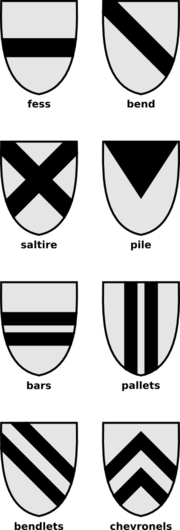Honourable ordinaries
From AmtWiki
Several different figures are recognised as honourable ordinaries. Each normally occupies one-fifth to one-third of the field; the precise amount depends on whether there are other charges on the ordinary or on the field.

- The chief is the upper portion of the field.
- The fess, a horizontal stripe in the centre of the field.
- The bar, which is of an indeterminate width, but if borne singly supposed to be slightly thinner than a fess.
- The pale, a vertical stripe in the centre of the field.
- The bend runs from the upper left to the lower right, as \, as seen by the viewer.
- The bend sinister runs from the upper right to the lower left, as /.
- The cross is a geometric construction of two perpendicular lines or bands, and is sometimes referred to as the "noblest" of the honourable ordinaries. It has hundreds of variants, most of which are common charges rather than ordinaries.
- The saltire, sometimes called Saint Andrew's cross, is a diagonal cross.
- The chevron is a construction shaped like an inverted letter V
- The pall is shaped like the letter Y. (There is a T-shaped charge, the tau, which is not understood to be an ordinary.)
- The pile is a triangle, whose base is along the top of the field, and whose vertex is in the centre of the bottom half of the field.
- The quarter is a rectangle occupying the top left quarter of the field, as seen by the viewer.
- The canton is a diminutive of the quarter.
Care must be taken in blazoning when two or more ordinaries or subordinaries, or diminutives thereof, are depicted "conjoined".